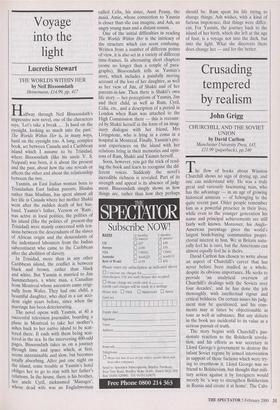Voyage into the light
Lucretia Stewart
THE WORLDS WITHIN HER by Neil Bissoondath Heinemann, 114.99, pp. 417 Halfway through Neil Bissoondath's impressive new novel, one of the characters says, 'Let's take a break ... Is hard on the eyesight, looking so much into the past.' The Worlds Within Her is, in many ways, hard on the eyesight too. A long, complex book, set between Canada and a Caribbean Island which I assume to be Trinidad, where Bissoondath (like his uncle V. S. Naipaul) was born, it is about the present and the past, about how the one reveals or affects the other and about the relationship between the two.
Yasmin, an East Indian woman born to Trinidadian East Indian parents, Hindus rather than Muslims, has spent almost all her life in Canada where her mother Shakti went after the sudden death of her hus- band. Yasmin's father, Vernon or 'Ram', was active in local politics; the politics of his island (like the politics of present-day Trinidad) were mainly concerned with ten- sions between the descendants of the slaves of African origin and the descendants of the indentured labourers from the Indian subcontinent who came to the Caribbean after the abolition of slavery. In Trinidad, more than in any other Caribbean island, the conflict is between black and brown, rather than black and white. But Yasmin is married to Jim Summerhayes, a white man, a Canadian from Montreal whose ancestors came origi- nally from Wales. They had one child, a beautiful daughter, who died in a car acci- dent eight years before, since when the marriage has been deteriorating. The novel opens with Yasmin, at 40 a successful television journalist, boarding a plane in Montreal to take her mother's ashes back to her native island to be scat- tered there. It ends with them being scat- tered in the sea. In the intervening 400-odd pages, Bissoondath takes us on a journey through time and space which, at first, seems interminable and slow, but becomes totally absorbing. After just one night on the island, some trouble at Yasmin's hotel Obliges her to go to stay with her father's relations. In the house, there is his brother, her uncle Cyril, nicknamed 'Manager', Whose dead wife was an Englishwoman called Celia, his sister, Aunt Penny, the maid, Arnie, whose connection to Yasmin is closer than she can imagine, and Ash, an angry young man and a distant cousin.
One of the initial difficulties in reading The Worlds Within Her is the intricacy of the structure which can seem confusing. Written from a number of different points of view, it is also set in a variety of different time-frames. In alternating short chapters (some no longer than a couple of para- graphs), Bissoondath tells us Yasmin's story, which includes a painfully moving account of the loss of her daughter, as well as her view of Jim, of Shakti and of her parents-in-law. Then there is Shakti's own life story — her perceptions of Yasmin, Jim and their child, as well as Ram, Cyril, Celia, etc., and a description of a period in London when Ram was attached to the High Commission there — this is recount- ed by Shakti herself in the form of an imag- inary dialogue with her friend, Mrs Livingstone, who is lying in a coma in a hospital in Montreal. Finally, Yasmin's pre- sent experiences on the island with her relations bring in their memories and opin- ions of Ram, Shakti and Yasmin herself.
Soon, however, you get the trick of read- ing the book and learn to recognise the dif- ferent voices. Suddenly the novel's incredible richness is revealed. Part of its strength and appeal is its absence of judg- ment. Bissoondath simply shows us how things are, rather than how they perhaps should be: Ram spent his life trying to change things; Ash wishes, with a kind of furious impotence, that things were differ- ent. For Yasmin, the journey back to the island of her birth, which she left at the age of four, is a voyage not into the dark, but into the light. What she discovers there does change her — and for the better.


























































 Previous page
Previous page